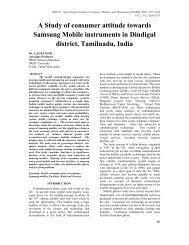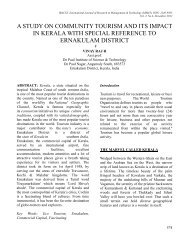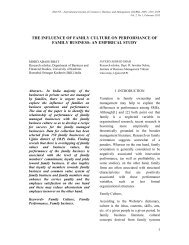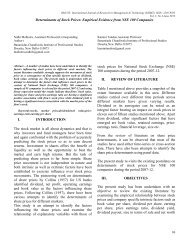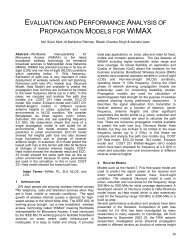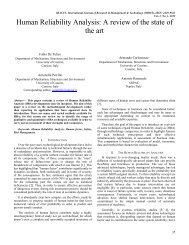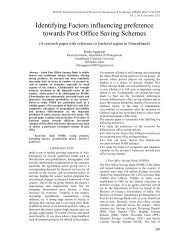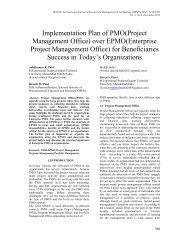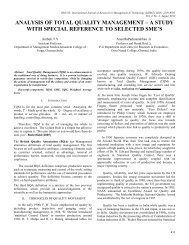A retrogressive Journey of Branded sarees: Commodity to Brand to ...
A retrogressive Journey of Branded sarees: Commodity to Brand to ...
A retrogressive Journey of Branded sarees: Commodity to Brand to ...
Create successful ePaper yourself
Turn your PDF publications into a flip-book with our unique Google optimized e-Paper software.
the government in some countries attracts indebtedness, suchas in the UK, through the availability <strong>of</strong> student loans. Theaccessibility <strong>of</strong> credit card is known as a contribu<strong>to</strong>ry elementin the trading-up and overspending constructs (Bakewell &Mitchell, 2003). However, the mass <strong>of</strong> influences that affectthe generation Y consumers is the media. The media couldinclude a wide range <strong>of</strong> technology.Marketers are the major people who contribute <strong>to</strong> thematter <strong>of</strong> influencing consumer behaviour through theknowledge <strong>of</strong> fashion. The reason is that teenagers areconcerned about fashion value more than any other age groups(Koester and May, 1985). The media, which include theinternet, mobile phones, and satellite television are sometechnology that generation Y consumers value (Meredith andSchewe, 2002). The valuation <strong>of</strong> technology such as televisionhas affected viewers in relation <strong>to</strong> materialism amongadolescents, and the duration <strong>of</strong> viewing televisionprogrammes consists <strong>of</strong> seven hours a day (Nielsen, 1995).Individuals are affected by television, and the possibility isthat the more viewers consume television it is more likely thatthey will reflect their perceptions in “reality” as they have seenin television world.Additionally, O’Guinn and Shrum (1997); Wells andAnderson (1996) stated that what is televised in association <strong>to</strong>characters and materials represent the more affluent wellbeings.Wysocki (1997) explains that there has been anincrease in addiction <strong>to</strong> technology such as MTV (musictelevision) and internet chat rooms that homogeniseindividuals preference and attitudes. As there is an increase inhomogenisation and technology such as MTV and internetchat rooms is distributed worldwide, it has created greatsimilarity between teens in different nations than older peoplein the same country (Anderson and Hee, 1998). Suchhomogenisation has created global teen values, expressingindependence, self expression, openness <strong>to</strong> new ideas, andteen cultural values (Meredith and Schewe, 2002). Theconcept <strong>of</strong> global teen values could attract marketers <strong>to</strong> targetthe teen industry with luxury and expensive products. Forexample, commercializing on MTV and shows that wouldattract consumers <strong>to</strong> buy luxury products that are associatedwith celebrities and heroes. The effect would causestandardisation in product consumption hence MTV istelevised worldwide and the same message would be putacross so that all teens would have the same desire across theworld. In order <strong>to</strong> understand the generation Y consumers, it isalso important <strong>to</strong> consider fac<strong>to</strong>rs that motivate theseindividuals <strong>to</strong>wards the purchasing <strong>of</strong> luxury goods.Individuals view the word “luxury” differently depending ontheir socioeconomic background. In the marketing context,consumers view the meaning <strong>of</strong> luxury goods through eitherpeople’s interaction such as aspired and/or peer referencegroup, or object property such as product quality and hedonicvalue. Luxury consumer’s behaviour has motivatedparticularly in sociability and self-expression (Vigneron &Johnson, 1999).IRACST – International Journal <strong>of</strong> Commerce, Business and Management (IJCBM), ISSN: 2319–2828Vol. 1, No3, December 2012Leibenstein (1950, p.188) classified demand <strong>of</strong> goodsand services consumption in relevant <strong>to</strong> motivation in<strong>to</strong> twomain aspects: functional and non- functional. Functionaldemand is “demand for a commodity which is due <strong>to</strong> thequalities inherent in the commodity itself”. On the contrary,demand <strong>of</strong> goods consumption that comes from other fac<strong>to</strong>rs,which is not the product quality, is defined non-functionaldemand. Additionally, Leibenstein (1950) suggests thatexternal effects on values are the most important nonfunctionaldemand. This can be further explained by twosituations. Firstly, the product has increased or decreased due<strong>to</strong> the quantity <strong>of</strong> consumers purchasing the same products,and secondly the product has a higher value.Conclusion:All said and done, <strong>of</strong>fering exclusivity and a rationalprice is something <strong>of</strong> a pipedream <strong>to</strong> saree marketers. Tillthen, women who desire saris must adjust <strong>to</strong> the idea <strong>of</strong> clonesor making a drastic shift from saris <strong>to</strong> salwar kameezes orwestern wear. Marketer must enhance Competitive Advantagethrough Ingredient <strong>Brand</strong>ing and <strong>Brand</strong> Ecosystem strategyusing its high quality cot<strong>to</strong>n <strong>to</strong> differentiate its cot<strong>to</strong>n andtextile products in the marketplace, and also <strong>to</strong> improve itscompetitive position in India and there by rejuvenate thebranded <strong>sarees</strong> among Indian population.REFERENCES1. Alkazi, Roshan (1983) "Ancient Indian costume", ArtHeritage; Ghurye (1951) "Indian costume", Popular bookdepot (Bombay); Boulanger, Chantal; (1997)2. Costumes <strong>of</strong> India and Pakistan: a his<strong>to</strong>rical and culturalstudy - Shiv Nath Dar - 19693. R. S. McGregor, ed (1997). The Oxford Hindi-EnglishDictionary. Oxford University Press. p. 1003.ISBN 9780198643395.4. Monier-Williams, Monier (1995). A Sanskrit-EnglishDictionary. Delhi: Motilal Banarsidass. p. 1063.ISBN 81-208-0065-6. http://www.sanskrit-lexicon.unikoeln.de/monier/index.html.Retrieved 2010-07-04.5. Kapoor, Subodh (2002). The Indian encyclopaedia:biographical, his<strong>to</strong>rical, religious, administrative,ethnological, commercial and scientific. Reunion-SatyaYauvana, Volume 20. Genesis Publishing Pvt Ltd.p. 6422 (pg no. starts from 6130).ISBN 9788177552577.http://books.google.co.in/books?id=Ieypjy0k2TsC&pg=PA6422. "The etymology <strong>of</strong> the word sari is from theSanskrit 'sati', which means strip <strong>of</strong> cloth. This evolvedin<strong>to</strong> the Prakriti 'sadi', and was later anglicised in<strong>to</strong> sari"6. Parthasarathy, R. (1993). The Tale <strong>of</strong> an Anklet: An Epic<strong>of</strong> South India – The Cilappatikaram <strong>of</strong> Ilanko Atikal,Translations from the Asian Classics. New York:Columbia Univ. Press. ISBN 0231078498.7. Bharata (1967). The Natyashastra [Dramaturgy], 2 vols.,2nd. ed. Trans. by Manomohan Ghosh. Calcutta:Manisha Granthalaya; Beck, Brenda (1976). "TheSymbolic Merger <strong>of</strong> Body, Space, and Cosmos in Hindu100



